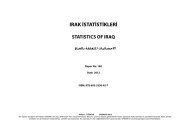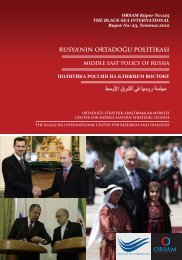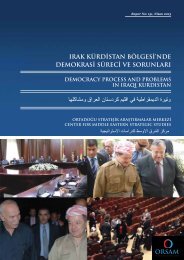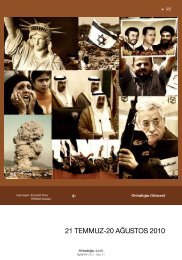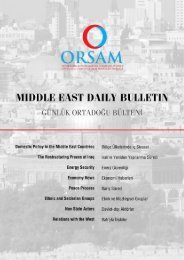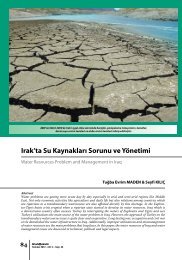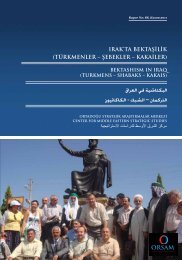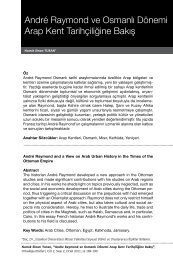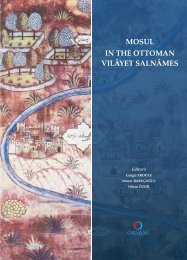SYRIAN CIRCASSIANS - orsam
SYRIAN CIRCASSIANS - orsam
SYRIAN CIRCASSIANS - orsam
Create successful ePaper yourself
Turn your PDF publications into a flip-book with our unique Google optimized e-Paper software.
<strong>SYRIAN</strong> <strong>CIRCASSIANS</strong><br />
ORSAM<br />
order to collect tax. However, Circassians did<br />
not accept this; and they also demanded cultivated<br />
lands in Maan region. Nazım Pasha<br />
asked the Consulate of Russia to send the disobedient<br />
Circassians back to North Caucasus.<br />
Nevertheless, he had to give up on this as the<br />
agreement signed between the two states prohibited<br />
repatriation of exiles. Circassian Husrev<br />
Pasha, who was assigned for the talks on<br />
September 1905, convinced his cognates to<br />
give up on their disobedience and to stay still<br />
for a little longer after long and hard talks. 16<br />
During the years of World War I, the Ottoman<br />
Empire declared mobilization in Circassian<br />
districts of Syria, and basic privates were<br />
sent to the areas where the battle was thick.<br />
Military command assigned Circassian police<br />
troops to protect the routes and food bases<br />
in Syria.<br />
In 1916, the Sharif of Mecca Hussein and his<br />
son Faisal initiated the Arab revolt supported<br />
by the Britain in 1916. Feeling the Ottoman<br />
pressure on themselves, Syrian Arabs actively<br />
supported the revolt. The Circassian people<br />
in this area had hard times in political terms.<br />
Their loyalty to the Ottoman Empire increased<br />
the hostile actions of Arabs, who considered<br />
Circassians as the soldiers of Ottoman State.<br />
The elders of Circassian villages remember<br />
the armed conflicts that constantly took place<br />
with Arabs. When the army of Sharif Hussein<br />
arrived in Northern Syria, Arabs who lived in<br />
the neighborhood of Circassian town Mumbuc<br />
asked them to destroy Mumbuc. Hearing<br />
of the approaching Arab army, Circassians<br />
sent a delegate declaring that local people of<br />
Mumbuc wanted to support the Arab revolt.<br />
This was the first event that Circassians took<br />
sides with Arabs during the years of war. In<br />
1920 when the French troops started to invade<br />
Syria, people of Mumbuc adhered to the<br />
agreement they had signed with Arabs and<br />
fought against the French troops. But they<br />
failed in the war where they fought against<br />
motorized units.<br />
In Transjordan, Circassians fought hard<br />
against the British troops. On March 1918,<br />
the Ottoman troops withdrew due to the<br />
pressure of the General Allenby’s 6 th British<br />
Army. Circassian troops clashed with the<br />
British troops. After the big losses on both<br />
parties, the British, who had an advantage<br />
both in number and in terms of weapon, won;<br />
and they invaded Transjordan.<br />
During the conference held in San Remo on<br />
April 1920, the victorious European states<br />
took the Arab territories from the Ottoman<br />
Empire for good. According to the mandate<br />
system, the League of Nations gave Iraq and<br />
Palestine back to Britain. The majority of Syria<br />
enterd under the rule of colonist regime of<br />
France.<br />
Despite in small numbers, Circassians’ immigration<br />
from North Caucasus to Syria<br />
cıntinued until the early 1920s. Circassians<br />
mostly settled in the Golan Heights, Transjordan,<br />
in the neighborhoods of Hama, Homs<br />
and Aleppo. 17 The Amman, Jerash, Kuneytra<br />
and Mumbuc villages they created grew bigger<br />
and turned into cities. 18 The last group<br />
of Circassians arrived in the aftermath of the<br />
World War II. This group was mostly composed<br />
of the former soldiers of the Red Army<br />
who were captured by the Germans and did<br />
not return to North Caucasus, and the young<br />
men who joined the German army in the invasion<br />
of North Caucasus by Nazi Germany<br />
in 1942.<br />
The mmigration continued until 1920s due to<br />
the reasons such as conflicts with neighboring<br />
tribes and the infertility of lands. While<br />
some groups immigrated from Syria, some<br />
others who were in the search of more fertile<br />
lands migrated within Syria; small settlements<br />
combined with the bigger ones. For instance,<br />
those who were the victims of contagious diseases<br />
in Damascus settled along with their<br />
cognates in Kuneytra.<br />
ORSAM<br />
Report No: 130, November 2012 17




